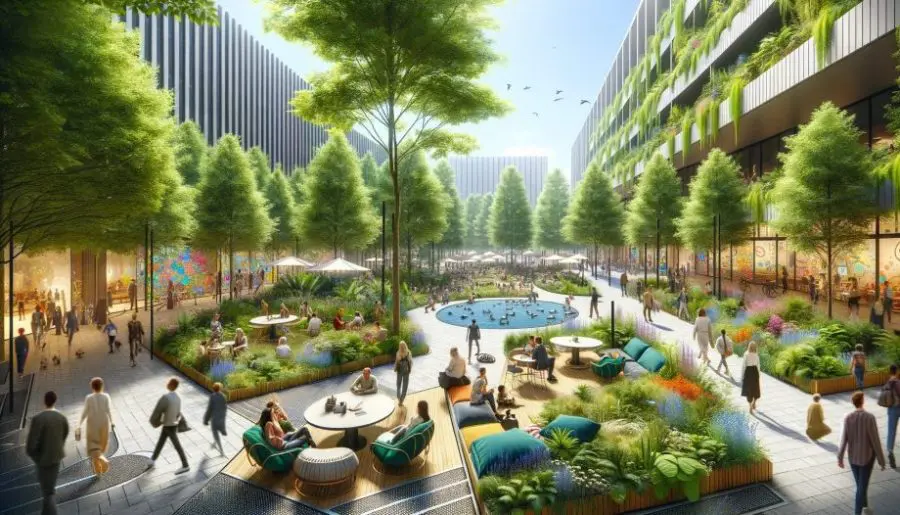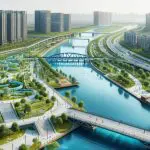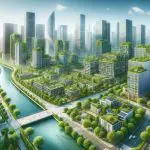
Why is green infrastructure important? Discover how it reshapes our cities for a sustainable future. Dive into the benefits of this eco-friendly approach!
Key Takeaways:
- Why is green infrastructure important?
- It’s vital for sustainable urban development
- It offers environmental benefits like improved air quality
- Stormwater management
- Economic advantages such as cost savings and job creation
- Social gains include enhanced public health and community well-being.
- It’s a multifaceted approach to building resilient, livable cities.
Have you ever wondered why green infrastructure is important? In our quest for sustainable living, green infrastructure stands out as a game-changer.
It intertwines the beauty of nature with urban development, creating spaces that not only look good but also enhance our environment and community well-being.
Let’s dive into the world of green infrastructure and uncover its critical role in shaping a sustainable future.
Why Is Green Infrastructure Important?
Green infrastructure is important because it integrates natural elements into urban areas, improving environmental quality, enhancing biodiversity, and managing stormwater.
It offers economic benefits like reducing costs and boosting property values, while also enhancing community well-being and public health.
This approach supports sustainable urban development and resilience against climate change.
Introduction to Green Infrastructure
The Rising Significance of Green Infrastructure
In recent years, there’s been a significant shift in how we think about infrastructure and urban development.
Traditionally, concrete and steel dominated our landscapes, but today, there’s growing interest in green infrastructure.
This approach is not only environmentally sustainable but also offers a range of economic benefits.
Why Green Infrastructure Matters
So, why is green infrastructure important? At its core, green infrastructure refers to an approach that integrates natural systems into urban planning.
This could include parks, green roofs, rain gardens, or even tree-lined streets.
These elements work together to create a more sustainable, resilient urban environment.
By mimicking natural processes, green infrastructure helps manage stormwater, reduces urban heat islands, and improves air and water quality.
Economic and Environmental Synergy
What’s truly remarkable about green infrastructure is how it bridges the gap between economic development and environmental stewardship.
It’s a cost-effective solution that enhances city livability, promotes biodiversity, and supports ecosystem services.
By integrating nature into our cities, green infrastructure also offers an opportunity for innovative design and urban beautification, which in turn can boost property values and attract investment.
Green infrastructure is a cost-effective, resilient approach to managing wet weather impacts that provides many community benefits. While single-purpose gray stormwater infrastructure—conventional piped drainage and water treatment systems—is designed to move urban stormwater away from the built environment, green infrastructure reduces and treats stormwater at its source while delivering environmental, social, and economic benefits. EPA.GOV
Understanding Green Infrastructure

Definition and Overview – What is Green Infrastructure?
Green infrastructure represents a paradigm shift in our approach to urban development and land use.
It’s an innovative concept that integrates natural elements and processes into the built environment.
At its simplest, green infrastructure is about creating and maintaining natural areas, incorporating plants and trees into urban settings, and using nature to manage water and mitigate environmental issues.
It’s a strategy that blends ecological integrity with human development.
Examples of Green Infrastructure
Examples of green infrastructure are diverse and adaptable to various environments. Some common examples include:
- Rain Gardens: These are small, depressed areas in landscapes designed to collect and filter rainwater runoff from roofs, driveways, and patios.
- Green Roofs: These are roofs of buildings that are partially or completely covered with vegetation and soil, or a growing medium, planted over a waterproofing membrane.
- Permeable Pavements: Special kinds of pavement that allow water to pass through into the ground, reducing runoff.
- Urban Tree Canopy: Trees planted in urban areas that provide shade, reduce heat island effects, and improve air quality.
- Bioswales: Landscape elements designed to remove silt and pollution from surface runoff water.
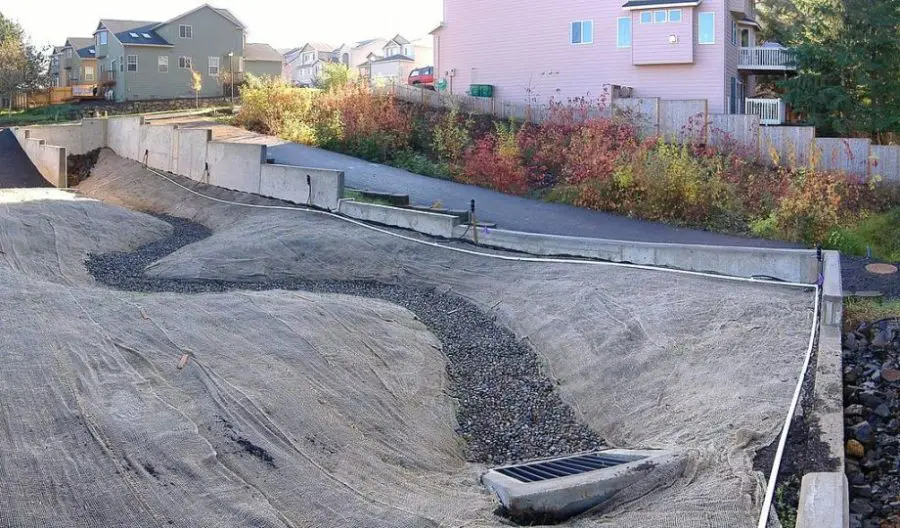
How Green Infrastructure Works
Basic Principles
The basic principles of green infrastructure revolve around enhancing and utilizing the natural environment in urban areas.
It’s about recognizing the value of natural systems and their ability to provide essential services like clean air, water filtration, and temperature regulation.
The goal is to create a symbiotic relationship between urban development and the natural environment, ensuring sustainability and resilience.
Green Infrastructure Techniques
Green infrastructure employs various techniques, each tailored to specific environmental and urban needs. Some of these techniques include:
- Rainwater Harvesting: Capturing and storing rainwater for later use.
- Constructed Wetlands: Man-made wetlands designed to treat wastewater or stormwater runoff.
- Urban Forestry: The careful planning and management of urban trees.
- Habitat Restoration: Restoring natural habitats in urban areas to promote biodiversity.
By integrating green infrastructure techniques into urban planning and development, cities can effectively address a range of environmental challenges.
This approach not only enhances urban ecosystems but also provides significant social and economic benefits.
In the following sections, we’ll explore these benefits in greater detail, revealing how green infrastructure is a key component in the quest for sustainable urban living.
Table: Understanding Green Infrastructure
Types of Green Infrastructure and Their Applications
| Type of Green Infrastructure | Description | Urban/Rural Application |
|---|---|---|
| Rain Gardens | Small, depressed areas designed to collect and filter rainwater runoff | Urban |
| Green Roofs | Roofs covered with vegetation to manage stormwater and improve insulation | Urban |
| Permeable Pavements | Pavements that allow water to pass through into the ground | Urban and Rural |
| Urban Tree Canopy | Trees planted in urban areas for shade and air quality improvement | Urban |
| Bioswales | Landscaped elements designed to remove pollutants from runoff water | Urban and Rural |
| Riparian Buffers | Vegetated areas near water bodies for filtering pollutants | Rural |
| Wetland Preservation | Protecting and restoring natural wetlands | Rural |
| Sustainable Agriculture | Agricultural practices that incorporate green infrastructure for soil and water health | Rural |
Environmental Benefits of Green Infrastructure
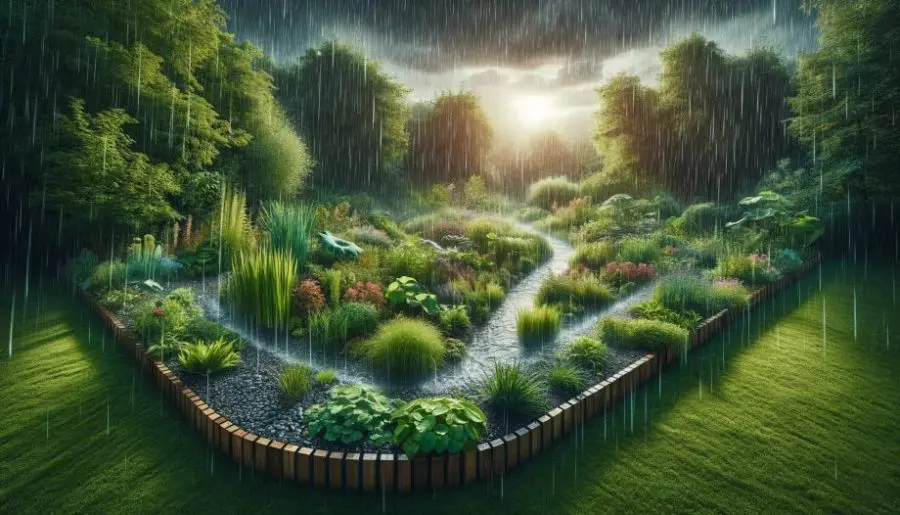
Impact on Ecosystems
How Green Infrastructure Benefits the Environment
Green infrastructure plays a pivotal role in enhancing urban ecosystems.
It’s not just about adding a touch of green; it’s about creating a thriving network of natural spaces that can significantly benefit the environment.
- Biodiversity and Habitat Creation: By incorporating elements like native gardens, green roofs, and urban forests, green infrastructure provides habitats for a wide range of species, fostering biodiversity in urban areas.
- Water Management and Quality: Natural landscaping techniques like bioswales and rain gardens help in filtering pollutants from runoff, thus improving water quality in local waterways.
- Air Quality Improvement: Trees and plants in urban areas act as natural air filters, absorbing pollutants and emitting oxygen, thereby improving air quality.
- Soil Stability and Quality: Green spaces help maintain soil health by preventing erosion, promoting microbial activity, and fostering a balanced ecosystem underground.
Green infrastructure is vital for maintaining ecological balance in urban areas.
It’s not just an aesthetic addition but a functional necessity that plays a crucial role in preserving and enhancing the natural environment.
Sustainability and Climate Resilience
Role in Mitigating Climate Change
Green infrastructure is a key player in the fight against climate change.
Its role in creating sustainable and resilient urban environments is increasingly recognized worldwide.
- Carbon Sequestration: Plants and trees in urban green spaces capture carbon dioxide, a major greenhouse gas, helping to mitigate the effects of climate change.
- Urban Heat Island Mitigation: Green infrastructure helps in reducing the urban heat island effect through shading and evapotranspiration, leading to cooler urban environments.
- Stormwater Management: Features like permeable pavements and green roofs absorb rainwater, reducing the risk of flooding and alleviating the pressure on urban drainage systems.
- Climate Adaptation: By incorporating green spaces, cities can adapt to climate change more effectively. These areas provide natural cooling, reduce flood risks, and create more resilient urban landscapes.
Understanding how green infrastructure benefits the environment and its significance in mitigating climate change is crucial.
It shows why green infrastructure is important to the environment, not just in terms of current environmental challenges but also in preparing for future climatic uncertainties.
In the next sections, we’ll explore the economic and social benefits of green infrastructure, demonstrating its all-encompassing role in creating sustainable urban futures.
Economic Advantages of Green Infrastructure
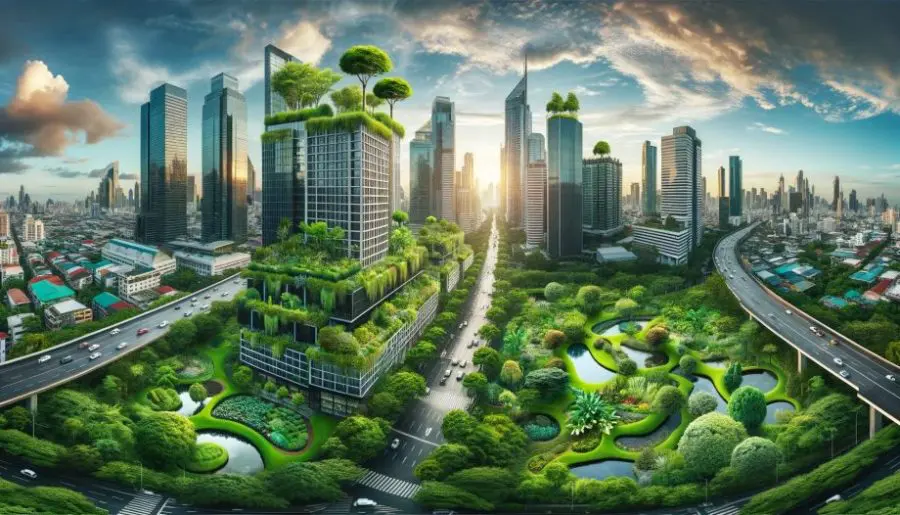
Cost-Effectiveness and Efficiency
Comparison with Traditional Infrastructure
Green infrastructure is not only environmentally beneficial but also economically advantageous, particularly when compared to traditional infrastructure.
- Lower Implementation Costs: In many cases, establishing green infrastructure like rain gardens or green roofs is less expensive than constructing traditional infrastructure like sewers or drainage systems.
- Reduced Maintenance Expenses: Once established, green infrastructure often requires less maintenance than traditional forms, leading to long-term cost savings.
- Energy Savings: Features like green roofs provide natural insulation, reducing the need for heating and cooling in buildings, and thereby lowering energy costs.
- Stormwater Management Efficiency: Green infrastructure efficiently manages stormwater, potentially reducing the need for expensive water treatment facilities.
The economic benefits of green infrastructure become evident when comparing these cost-effective and efficient solutions to more traditional, often costlier infrastructure options.
Boosting Local Economies
Job Creation and Property Value Increase
Green infrastructure also plays a significant role in stimulating local economies.
- Job Creation: The design, installation, and maintenance of green infrastructure create new job opportunities in fields like landscaping, urban planning, and environmental science.
- Increased Property Values: Properties with green amenities or those near green spaces often see an increase in value, benefiting homeowners and the community.
- Stimulating Local Businesses: Green spaces can attract visitors and increase foot traffic, providing a boost to local businesses.
- Enhanced Investment Attraction: Cities with well-integrated green infrastructure are more attractive to investors, who often seek sustainable and environmentally friendly development opportunities.
By understanding and harnessing these economic advantages, communities can make informed decisions about urban development, leading to sustainable growth and prosperity.
The next sections will delve into the social benefits of green infrastructure, showcasing its comprehensive impact on urban life.
Table: Economic Advantages of Green Infrastructure
Economic Comparison: Green vs. Traditional Infrastructure
| Factor | Green Infrastructure | Traditional Infrastructure |
|---|---|---|
| Initial Cost | Generally lower | Higher |
| Maintenance Cost | Lower long-term | Higher long-term |
| Energy Efficiency | High (e.g., natural insulation) | Lower |
| Impact on Property Value | Positive impact | Variable impact |
| Job Creation Potential | High (diverse fields) | Lower (specific fields) |
Social and Community Impacts
Health and Well-being
Impact on Public Health and Mental Health
Green infrastructure significantly contributes to the health and well-being of communities.
- Physical Health Benefits: Green spaces encourage physical activities like walking, jogging, and cycling. Access to such spaces is linked to lower obesity rates and improved overall physical health.
- Mental Health Advantages: Exposure to greenery has been shown to reduce stress, anxiety, and depression. Natural environments offer a calming and rejuvenating break from the urban hustle.
- Air Quality Improvement: By filtering pollutants and providing cleaner air, green infrastructure contributes to reduced respiratory problems and overall better health.
- Heat Reduction: Green areas mitigate the urban heat island effect, decreasing heat-related health risks, especially during intense summer months.
These aspects highlight the social benefits of green infrastructure, emphasizing its role in promoting public health and mental well-being in urban communities.
Enhancing Urban Livability
Community Engagement and Aesthetic Improvements
Green infrastructure goes beyond environmental and economic impacts; it plays a vital role in enhancing the quality of urban life.
- Community Spaces: Green infrastructure creates communal spaces for social interactions, fostering a sense of community and belonging.
- Aesthetic Appeal: Urban green spaces enhance the aesthetic appeal of neighborhoods, making them more inviting and pleasant places to live.
- Encouraging Community Participation: Projects like community gardens bring people together, promoting active community engagement and a sense of ownership.
- Cultural and Educational Opportunities: Green spaces can be used for cultural events, educational programs, and other community activities, enriching the cultural fabric of the city.
By improving urban livability and fostering community engagement, green infrastructure enhances the social fabric of cities, making them not just more livable, but more lovable.
The next sections will explore practical examples of green infrastructure implementation and address frequently asked questions to provide a comprehensive understanding of this important topic.
Table: Social and Community Impacts
Social Benefits of Green Infrastructure
| Benefit Type | Description |
|---|---|
| Physical Health | Encourages activities like walking, reduces obesity rates |
| Mental Health | Reduces stress and anxiety, improves overall well-being |
| Community Engagement | Creates communal spaces for social interaction |
| Aesthetic Improvements | Enhances the visual appeal of urban areas |
Implementation and Examples
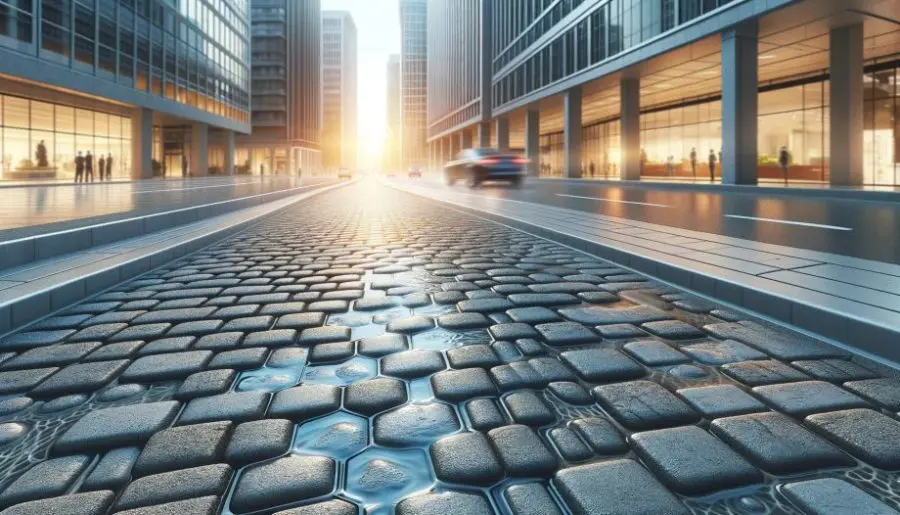
Where Green Infrastructure Can Be Used
Urban and Rural Applications
Green infrastructure is versatile and can be implemented in various settings, both urban and rural.
- Urban Applications:
- City Parks and Green Belts: These provide recreational space and natural beauty in dense urban areas.
- Green Roofs and Walls: Used in buildings to reduce heating and cooling costs, manage stormwater, and improve air quality.
- Street Trees and Urban Forests: These enhance the streetscape and provide shade, reducing the urban heat island effect.
- Rural Applications:
- Riparian Buffers: Vegetated areas near rivers and streams that help in filtering pollutants and stabilizing banks.
- Wetland Preservation and Restoration: Protects biodiversity and serves as a natural filter for water.
- Sustainable Agricultural Practices: Incorporating green infrastructure in agriculture to improve soil health and water management.
This variety answers the question of where can we use green infrastructure, showcasing its adaptability and wide-ranging applicability.
Case Studies and Success Stories
Green Stormwater Infrastructure Examples
Green stormwater infrastructure is a key application of green infrastructure, and numerous success stories illustrate its effectiveness.
- Philadelphia’s Green City, Clean Waters Program: This initiative involves a comprehensive plan to reduce stormwater pollution through green infrastructure. It includes rain gardens, green roofs, and permeable pavements.
- New York City’s Green Infrastructure Plan: NYC has invested in green roofs, rain gardens, and bioswales to manage its stormwater sustainably.
- Portland’s Green Streets Program: Portland has transformed its streetscapes with bioswales, planters, and green roofs to manage stormwater and add greenery to the urban environment.
These green stormwater infrastructure examples demonstrate how cities across the world are embracing green solutions to manage water in sustainable and cost-effective ways.
These initiatives not only address environmental concerns but also enhance urban livability, proving the multifaceted benefits of green infrastructure.
In the upcoming section, we’ll address some of the most frequently asked questions about green infrastructure, helping to clear up common misconceptions and provide additional insights.
Why Is Green Infrastructure Important? FAQs
Green infrastructure is a topic that often raises many questions. To help clarify some of the common queries, here’s a look at the most frequently asked questions and their answers.
Q: Why Do We Need Green Infrastructure?
A: Green infrastructure is essential for several reasons:
- Environmental Protection: It helps in managing stormwater, reducing urban heat islands, and improving air and water quality.
- Economic Benefits: It is cost-effective, reduces energy consumption, and can increase property values.
- Social and Health Benefits: Green spaces improve mental and physical health and foster community engagement.
- Climate Resilience: It helps cities adapt to climate change effects, such as increased rainfall and rising temperatures.
The need for green infrastructure stems from its multi-dimensional benefits that address both current urban challenges and future sustainability.
Q: Can Green Infrastructure be Applied in All Types of Climates?
A: Yes, green infrastructure can be adapted to various climates:
- Temperate Climates: Features like rain gardens and green roofs are effective in managing rainfall and enhancing greenery.
- Arid and Semi-arid Climates: Techniques like xeriscaping and drought-tolerant plants can be used to conserve water and provide green spaces.
- Tropical Climates: Green infrastructure in these areas focuses on flood mitigation, such as bioswales and permeable pavements.
Each climate has unique challenges and opportunities, and green infrastructure can be tailored to fit these specific needs.
Q: Are There Any Disadvantages to Green Infrastructure?
A: While green infrastructure has many benefits, there are some challenges:
- Initial Costs: Some green infrastructure projects may have higher upfront costs than traditional infrastructure.
- Maintenance: Regular maintenance is required to ensure the effectiveness of green infrastructure systems.
- Space Requirements: In highly urbanized areas, finding space for green infrastructure can be challenging.
Despite these challenges, the long-term benefits of green infrastructure often outweigh the initial hurdles, making it a worthwhile investment for sustainable urban development.
Understanding these FAQs helps in gaining a comprehensive view of green infrastructure, its importance, and how it can be effectively implemented in various settings.
Why Is Green Infrastructure Important? Conclusion
Embracing Green Infrastructure for a Sustainable Future
As we’ve explored throughout this blog, green infrastructure presents a dynamic and multifaceted approach to urban planning and environmental management.
Its benefits extend far beyond beautifying our cities; they touch every aspect of our lives, from the air we breathe to the water we drink.
Summarizing the Benefits of Green Infrastructure
- Environmental Stewardship: Green infrastructure plays a crucial role in enhancing urban ecosystems, improving biodiversity, and managing stormwater.
- Economic Viability: It offers a cost-effective alternative to traditional infrastructure, reducing long-term expenses and boosting local economies through job creation and increased property values.
- Social and Health Advantages: By improving air quality and providing green spaces, green infrastructure contributes significantly to physical and mental well-being.
- Sustainability and Resilience: It helps cities become more resilient against climate change impacts and paves the way for sustainable urban development.
The Path Ahead
The importance and benefits of green infrastructure cannot be overstated as Nature-Based Solutions to Climate Change.
It’s not just an option but a necessity for building sustainable, resilient, and healthy urban environments.
As we move forward, integrating green infrastructure into our cities will be key to addressing the environmental challenges of our time and ensuring a better quality of life for future generations.
Let’s embrace green infrastructure not just as a concept but as a practice, making it an integral part of our approach to urban development and environmental conservation.
Together, we can create greener, more sustainable cities that thrive in harmony with nature.

